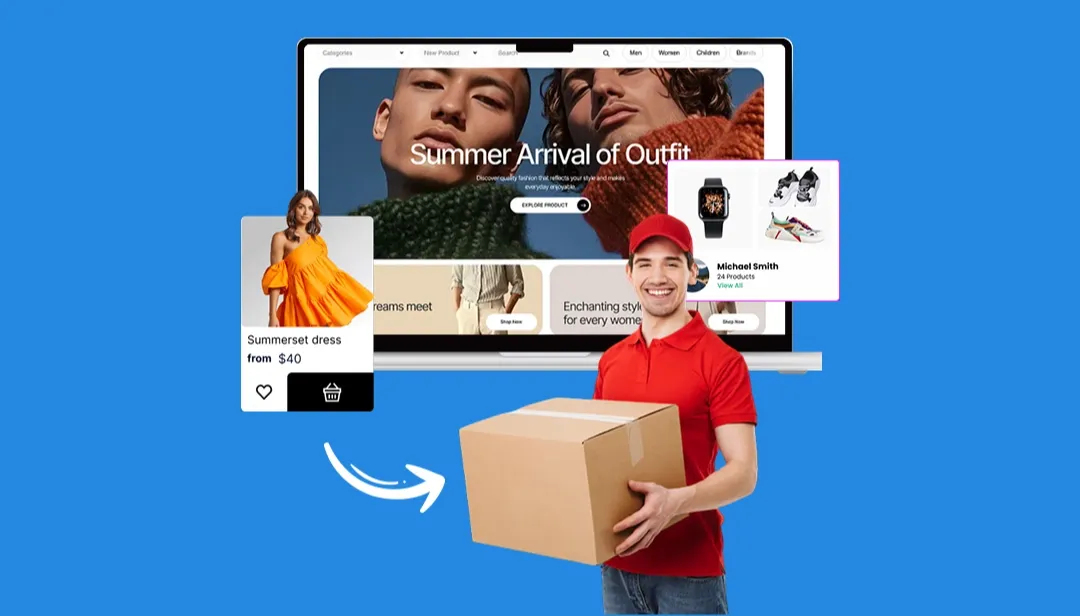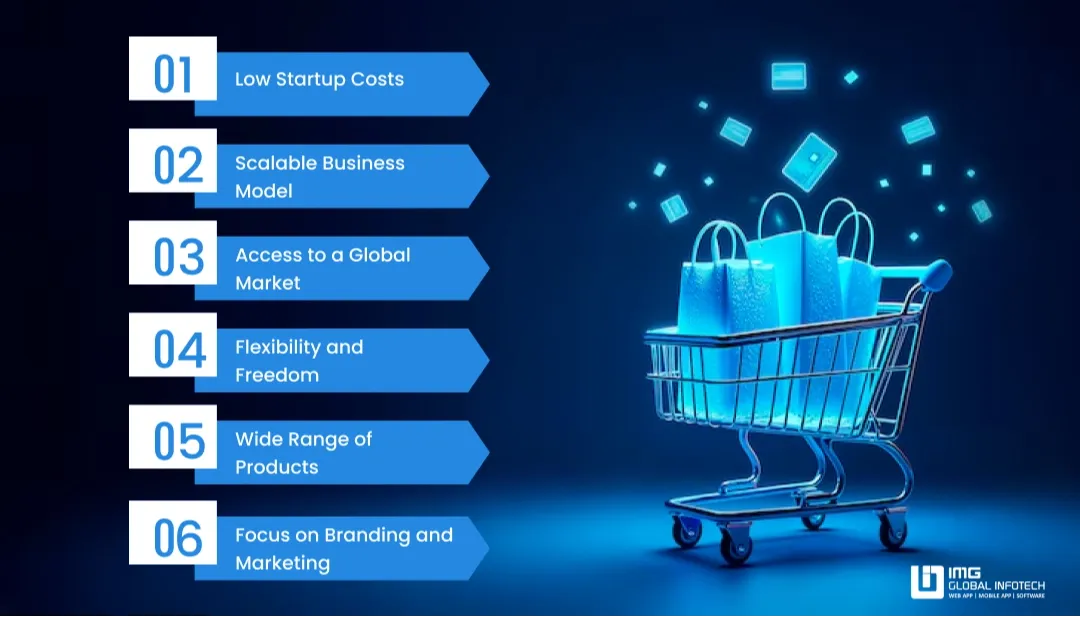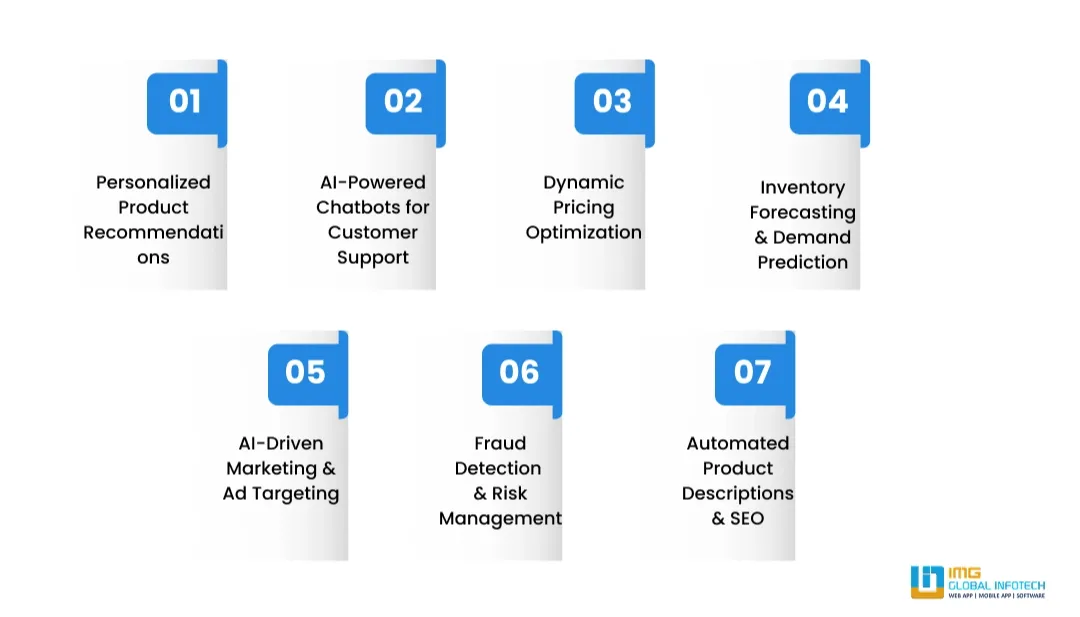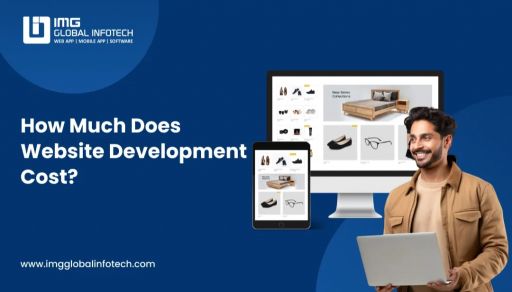How To Build A Dropshipping Website?
Dipti Singhal
Aug 04, 2025

Dropshipping has completely transformed the way entrepreneurs start online businesses. Unlike traditional retail models, it allows you to sell products without the need to invest in bulk inventory or manage a warehouse. All you need is a well-designed website, reliable suppliers, and a solid marketing plan to get started.
In recent years, dropshipping has become a go-to choice for aspiring business owners because of its low startup costs, flexibility, and global reach. But while the idea sounds simple, building a successful dropshipping website involves more than just adding products to a store. From choosing the right niche and platform to ensuring smooth customer experiences, every step plays a crucial role in your business growth.
In this guide, we’ll walk you through the complete process of website development for dropshipping, from planning and setup to launching and scaling, so you can start your online store with confidence.
How A Dropshipping Website Works?
A dropshipping website acts as the bridge between customers and suppliers. Unlike a traditional eCommerce store that stocks products in a warehouse, a dropshipping site doesn’t hold any physical inventory. Instead, it displays products from third-party suppliers and handles the order process.
Here’s how it works step by step
1. Customer Places an Order
A visitor browses your dropshipping website, selects a product, and makes a purchase. The payment is processed directly on your site.
2. Order Sent to Supplier
Once the order is confirmed, the details are automatically forwarded to your chosen dropshipping supplier (through integrated apps or manually).
3. Supplier Prepares and Ships the Product
The supplier packs the product and ships it directly to the customer, using your store’s branding (if private labeling or white labeling is enabled).
4. Customer Receives the Product
The customer gets their package as if it came directly from your store, without knowing the supplier’s involvement in the process.
Why Invest in Dropshipping Website Development?

Investing in dropshipping website development is one of the smartest moves for entrepreneurs looking to start an online business with minimal risk. Unlike traditional retail, where you need a physical store or large inventory, dropshipping offers a low-barrier entry into eCommerce app development while still giving you access to a global customer base.
Here are some key reasons why to create a dropshipping website is a worthwhile investment:
1. Low Startup Costs
You don’t need to buy products in bulk or rent storage space. The website becomes your main asset, reducing upfront expenses.
2. Scalable Business Model
Whether you want to sell 10 products or 1,000, your dropshipping site can scale without major operational challenges.
3. Access to a Global Market
With the right marketing, you can reach customers worldwide without worrying about logistics, your suppliers handle that part.
4. Flexibility and Freedom
You can manage the business from anywhere with just a laptop and internet connection, making it perfect for digital entrepreneurs.
5. Wide Range of Products
Your website can offer thousands of products without physically stocking them, allowing you to adapt quickly to market trends.
6. Focus on Branding and Marketing
Since suppliers handle inventory and fulfillment, you can invest your time and resources into building a strong brand and attracting customers.
How to Make a dropshipping website: Step-By-Step Guide
Developing a dropshipping website involves more than just picking a platform and adding products. Every decision, from your niche to your marketing affects your success. Here’s a complete step-by-step guide to build a dropshipping website that walks you through the entire process:
1. Choose Your Niche
Your niche determines your store’s focus, target audience, and competitive edge. Instead of selling “everything,” narrow it down to products that have:
-
Steady or growing demand (check Google Trends or keyword research)
-
Decent profit margins (consider wholesale vs. retail price)
-
Low to moderate competition (research existing stores and marketplaces)
2. Select the Right Platform
Your B2C eCommerce platform will be the foundation of your dropshipping website. Each platform comes with its own features and flexibility:
-
Shopify – Best for beginners; offers easy integrations with apps like DSers, Oberlo, and Spocket.
-
WooCommerce (WordPress) – Great for customization; ideal for those who want more control over their store.
-
BigCommerce, Wix, or Squarespace – Suitable for small to medium-sized stores that want a quick setup.
3. Register a Domain Name and Hosting
Your domain name is your store’s identity. Keep it:
-
Short and easy to remember
-
Relevant to your products or brand
-
Free from numbers or complicated spellings
For hosting:
-
Shopify includes secure hosting in its subscription.
-
WooCommerce requires a web hosting provider like SiteGround, Bluehost, or Hostinger.
4. Design Your Website
Your website design services directly impact customer trust and conversion rates.
-
Choose a theme that fits your niche (Shopify and WordPress both offer free and premium themes).
-
Customize colors, fonts, and layout to align with your brand identity.
-
Ensure mobile responsiveness because most online shopping now happens on smartphones.
5. Integrate Dropshipping Apps or Plugins
Dropshipping automation tools make product import, inventory sync, and order fulfillment effortless.
Popular options:
-
Oberlo (Shopify)
-
Spocket (US/EU suppliers)
-
DSers (AliExpress integration)
-
AliDropship (WordPress plugin)
6. Add and Optimize Products
Adding products is more than just importing supplier details.
-
Write unique product descriptions instead of using generic supplier text (better for SEO and conversions).
-
Optimize titles and descriptions with relevant keywords customers are searching for.
-
Use high-quality images ideally lifestyle or real-use photos rather than stock photos.
-
Set competitive pricing while maintaining healthy profit margins.
7. Set Up Payment Gateways and Shipping
Your payment system should be secure and convenient for your target audience.
-
Popular payment gateways: PayPal, Stripe, Razorpay, or credit/debit card processors.
-
Ensure multiple currency support if you’re selling globally.
For shipping:
-
Decide on your delivery zones (domestic or international).
-
Clearly mention estimated delivery times and costs to avoid customer dissatisfaction.
8. Test Your Website Before Launch
Before going live, test your site like a customer would:
-
Add products to cart and proceed to checkout.
-
Test payment gateways with a small transaction.
-
Check email notifications for order confirmations and updates.
-
Review mobile and desktop experiences to ensure smooth navigation.
9. Launch and Promote Your Store
Once everything is working perfectly, it’s time to launch. But a website without traffic won’t generate sales, so create a marketing plan:
-
Social Media Marketing (Instagram, TikTok, Facebook)
-
Paid Advertising (Facebook Ads, Google Ads)
-
Influencer Marketing (partner with niche influencers)
-
SEO Optimization (blog content, backlinks, product page optimization)
Key Features of A Website For Dropshipping
A successful dropshipping website development is more than just an online storefront. It needs the right mix of design, functionality, and trust-building elements to attract visitors and turn them into loyal customers. Each feature plays a crucial role in ensuring a smooth shopping experience, better search visibility, and higher conversions.
1. User-Friendly Navigation
A clear, simple menu and search bar make it easy for shoppers to find products. Filters and sorting options enhance the experience, encouraging customers to browse more and make purchases.
2. Mobile-Responsive Design
Your store should adapt perfectly to all devices. A mobile-friendly design ensures smooth navigation, quick load times, and easy checkout for users on smartphones and tablets.
3. High-Quality Product Pages
Product pages should have clear titles, unique descriptions, quality images, and engaging videos created with a product video maker. Including product variants, videos, and lifestyle images builds trust and boosts conversions.
4. Secure Payment Gateways
Secure, trusted payment gateways like PayPal, Stripe, or Razorpay inspire confidence. An SSL certificate ensures safe transactions and protects customer data.
5. Automated Inventory Management
Automated inventory updates prevent overselling and sync stock levels with suppliers. This saves time and ensures product availability is always accurate.
6. Fast Loading Speed
A fast website keeps customers engaged and reduces cart abandonment. Optimized images, lightweight themes, and reliable hosting improve speed and performance.
7. Clear Shipping & Return Policies
Transparent shipping costs, delivery timelines, and a simple return policy build trust. These details should be visible on product and checkout pages.
8. Customer Reviews and Ratings
Authentic reviews and ratings create social proof. Even mixed reviews look genuine and help customers feel confident about buying.
9. Multi-Currency & Multi-Language Support
Offering local currencies and language options improves the shopping experience for global customers, boosting conversion rates.
10. Live Chat & Customer Support
Live chat provides instant assistance and builds trust. Automated chatbots and multiple contact options improve customer satisfaction.
11. SEO-Friendly Structure
An SEO-optimized site structure with clear URLs, meta tags, and product descriptions improves search visibility and attracts organic traffic.
12. Analytics & Tracking Tools
Tools like Google Analytics and Facebook Pixel provide insights into visitor behavior, helping optimize marketing and boost sales.
How much does it cost to develop a dropshipping website?
The cost of developing a dropshipping website can range between $10,000 to $40,000+, depending on factors such as the platform you choose (Shopify, WooCommerce, or custom-built), the level of customization, integrated features, and whether you hire dedicated website developers or use DIY tools. A simple, ready-to-use store with prebuilt templates will cost significantly less than a fully customized website with advanced automation, branding, and scaling features. On average, dropshipping like ecommerce website development costs can range from a few hundred dollars for a basic store to several thousand for enterprise-grade solutions.
Latest Trends In Dropshipping Website Using AI

AI development is reshaping dropshipping websites by automating tasks, improving customer experiences, and boosting sales. Here are some of the latest AI development trends in the industry:
1. Personalized Product Recommendations
AI analyzes customer behavior, purchase history, and preferences to suggest relevant products, increasing conversion rates.
2. AI-Powered Chatbots for Customer Support
Virtual assistants respond instantly to queries, provide order updates, and assist with product selection, enhancing the overall shopping experience.
3. Dynamic Pricing Optimization
AI tools monitor competitor pricing, demand changes, and market trends to adjust product prices for maximum profitability.
4. Inventory Forecasting & Demand Prediction
Predictive algorithms estimate product demand, helping avoid stockouts or overstocking issues.
5. AI-Driven Marketing & Ad Targeting
Machine learning tools segment audiences and optimize ad campaigns for better ROI across platforms like Facebook, Google, and Instagram.
6. Fraud Detection & Risk Management
AI systems detect suspicious transactions and protect stores from chargebacks or fraudulent activities.
7. Automated Product Descriptions & SEO
Natural Language Processing (NLP) tools create optimized product descriptions, meta tags, and titles to improve search engine rankings
Why Choose Img Global Infotech for Dropshipping Website Development?
Selecting the right dropshipping website development company is one of the most important decisions when starting a retail business. At IMG Global Infotech, we bring together technical expertise, industry experience, and a client-first approach to create dropshipping websites that are built for performance and scalability. Our team has deep knowledge of popular eCommerce platforms such as Shopify, WooCommerce, and BigCommerce, enabling us to recommend and implement the solution that best aligns with your business goals.
We focus on creating websites that are visually appealing, user-friendly, and optimized for conversions. Every design is crafted to offer smooth navigation, fast loading times, and mobile responsiveness, ensuring your customers enjoy a seamless shopping experience. With IMG Global Infotech, you don’t just get a website, you get a reliable eCommerce partner committed to helping your business grow.
Conclusion
Building a dropshipping website is one of the most accessible ways to enter the eCommerce world with minimal risk and investment. With the right niche, a well-designed store, and smart automation tools, entrepreneurs can create a scalable business that caters to a global audience. By integrating the latest trends, such as AI in shopping app, dynamic pricing, and intelligent inventory management, you can stay competitive in a fast-evolving market. Whether you’re starting small or aiming for enterprise-level growth, investing in a professional, feature-rich dropshipping website sets the foundation for long-term success
Dipti Singhal is a skilled Content Writing Specialist at IMG Global Infotech, with strong expertise in creating engaging, SEO-optimized content for various industries. She focuses on blending storytelling with effective keyword strategies to help businesses connect with their audience and improve their online visibility. Passionate about delivering high-quality content that drives real results, Dipti plays an essential role in strengthening the company’s digital presence.












